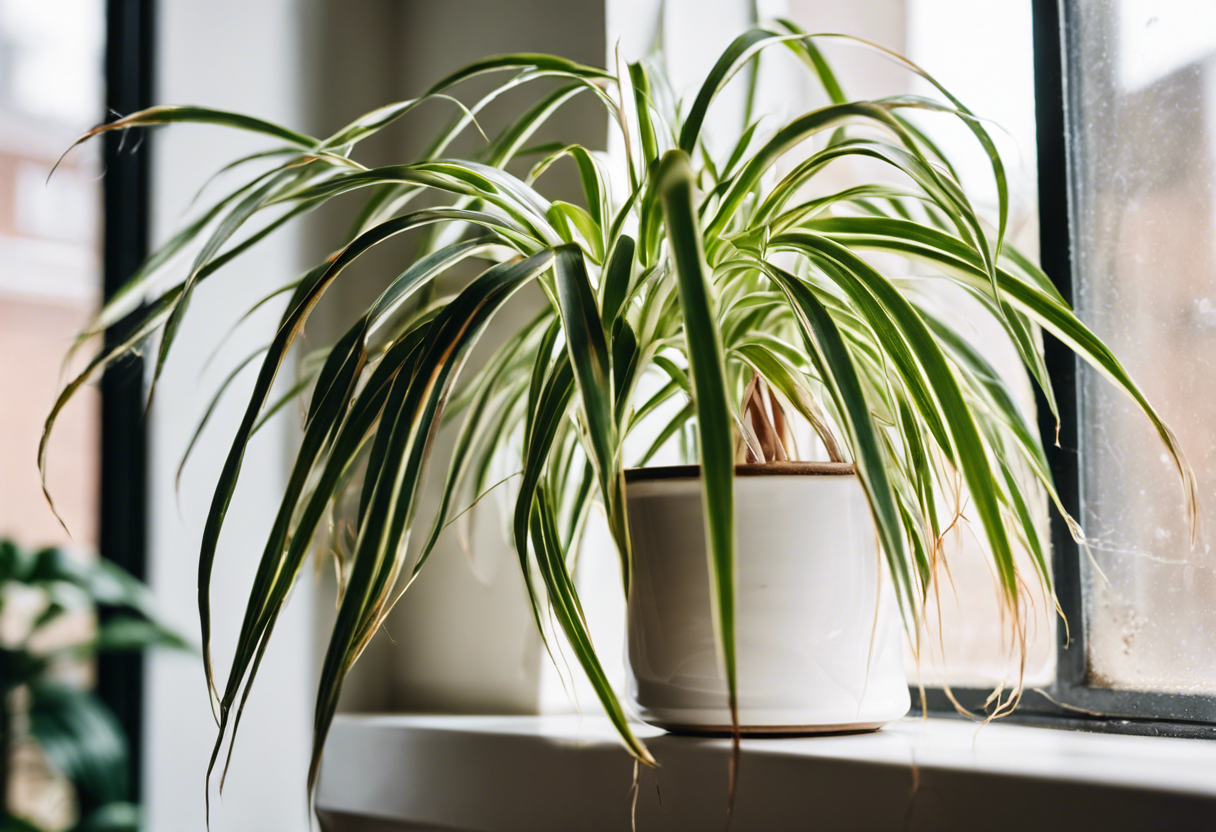Ever looked at your beloved spider plant and thought, “Why, oh why, are you turning brown on me?” Well, you’re not alone. It’s a common issue that many of us plant parents face. But don’t worry, I’m here to help you Save a Spider Plant with Brown Leaves.
In this guide, we’ll dive into the nitty-gritty of what causes those pesky brown leaves and tips. We’ll also explore some foolproof solutions to bring back the lush green glory of your spider plant. So buckle up, fellow green thumbs! Keep reading about ‘How to Save a Spider Plant with Brown Leaves and Leaf Tips’.
Key Takeaways
- Brown leaves and leaf tips on a spider plant can be due to overwatering, low humidity, or nutrient deficiency.
- To save the plant, first trim off the brown parts to prevent further damage.
- Adjust watering habits; ensure the soil is dry before watering again.
- Increase humidity by placing the plant on a tray of pebbles with water or using a humidifier.
- Feed the plant with balanced liquid fertilizer every 2 weeks during growing season.
Understanding Spider Plant Problems
Spider plants are generally hardy, but they’re not immune to a few pesky problems. One of the most common issues is browning leaves and leaf tips. This can be quite alarming, especially if you’re new to spider plant care. But don’t worry, we’re here to help you save a spider plant with brown leaves.
Identifying Brown Leaves and Leaf Tips
First things first, let’s learn how to spot the signs of trouble. Identifying brown leaves on your spider plant isn’t rocket science. The vibrant green foliage will start turning a dull brown color. It’s like your plant is wearing a sign saying “Hey, I’m stressed out here!”
But it’s not just about the leaves turning brown. You also need to keep an eye out for leaf tip browning. This usually starts at the very tip of the leaf and works its way down towards the base. It’s like your spider plant is slowly dipping its toes into a pool of chocolate (only less delicious and more worrisome).
Common Causes of Browning in Spider Plants
Now that we know what to look for, let’s talk about why this happens. One common cause is overwatering. Spider plants are like those friends who love their personal space – too much attention (or water) can make them uncomfortable.
Another cause could be lack of sunlight. Just like us humans, spider plants need their daily dose of sunshine too! So if your plant isn’t getting enough light, it might start showing signs of stress by turning brown.
Remember folks, understanding these indoor plants problems is half the battle won in trying to save your beloved green buddy from turning into a crispy critter!
Diagnosing Your Spider Plant’s Condition
When you’re trying to save a Spider Plant with brown leaves, the first step is always a proper diagnosis. It’s like playing plant detective, and you’re on the case of the browning leaf tips!
Assessing Watering Practices
Now, let’s talk about water. Too much love (read: water) can drown your plant, while too little can leave it parched. Overwatering symptoms often include yellowing leaves and root rot. On the other hand, underwatering effects might show up as dry, crispy leaf tips.
The trick is finding that Goldilocks zone of watering – not too much, not too little, but just right! Remember, these babies are native to South Africa where they’ve adapted to periods of drought. So when in doubt, less is more!
Checking Light Conditions
Next up on our spider plant care checklist is light conditions. These plants are pretty chill when it comes to lighting. They can handle low light but thrive in bright indirect light.
If your spider plant has been sunbathing a bit too much lately, you might notice some sunburns (yes plants get sunburns too!). This usually shows up as bleached or scorched leaves. On the flip side, if your plant isn’t getting enough rays (effects of low light on houseplants), it might start looking a bit pale and leggy.
Evaluating Soil and Pot Conditions
Last but certainly not least in our spider plant diagnosis is checking out the soil and pot conditions. The type of soil you use matters big time! Spider plants prefer well-draining soil that allows their roots to breathe.
If your pot doesn’t have good drainage (drainage problems in pots) or if it’s too small (pot size for houseplants), this could lead to root rot and you guessed it – brown leaf tips. So make sure your plant baby has plenty of room to grow and that water can easily escape the pot.
How to Treat a Spider Plant with Brown Leaves and Leaf Tips
When you spot brown leaves or tips on your spider plant, it’s time for some TLC. The common culprits are usually watering techniques, light exposure, and soil conditions. Let’s dive into how we can save a Spider Plant with Brown Leaves.
Adjusting Watering Techniques
Watering issues are often the root of the problem (pun intended!). Overwatering or underwatering can lead to those dreaded brown leaf tips. Even the water quality can impact your spider plant’s health.
So what’s the solution? Well, it’s all about balance. Spider plants like their soil to be moist but not soggy. So give them a good drink, then let the top inch of soil dry out before watering again. And remember, they’re not too fussy about water type – tap water will do just fine!
Modifying Light Exposure
Next up is light exposure. Too much sun can leave your spider plant feeling a bit… crispy. On the flip side, too little light and it’ll start to lose its vibrant green color.
The sweet spot? Bright but indirect light is perfect for these guys. Place them near a north-facing window or in a well-lit room away from direct sunlight. They’ll thank you for it!
Changing Soil or Repotting
Finally, let’s talk dirt (or rather, soil). If your spider plant has been in the same pot for ages, it might be time for a change.
Signs that repotting is needed include roots poking out of the drainage holes or tightly packed soil that doesn’t drain well. When repotting, choose a well-draining potting mix – these plants don’t like wet feet!
And there you have it! With these tweaks to watering, lighting and soil conditions, you’ll be on track to save your Spider Plant with Brown Leaves.
Preventive Measures for Healthy Spider Plants
Preventive measures are your best bet to maintain healthy spider plants. It’s like a wellness routine for your green buddies, focusing on watering practices, light conditions, and soil and pot requirements.
Ideal Watering Practices for Spider Plants
When it comes to watering spider plants, there’s a Goldilocks zone. Too much or too little water can lead to brown leaves. The trick is to keep the soil moist but not soggy.
How often you water depends on several factors like humidity, temperature, and the size of the plant. Generally speaking, watering once a week should do the trick. Remember, overwatering is one of the common causes of brown leaves in spider plants.
Optimal Light Conditions for Spider Plants
Light plays a crucial role in spider plant care. These plants love bright but indirect light. Too much direct sunlight can scorch their leaves while too little light can stunt their growth.
Different lighting conditions affect their health differently. For instance, if your plant is getting too much light, its leaves might turn yellowish-green instead of deep green. On the other hand, insufficient light might cause slow growth and less vibrant foliage.
Preferred Soil and Pot Requirements
The right soil and pot can make a world of difference in preventing brown leaves in spider plants. Spider plants prefer well-draining soil – think loamy or sandy mixtures that allow water to flow freely.
As for pots, opt for ones with drainage holes at the bottom to prevent waterlogging which could lead to root rot and subsequently brown leaves. A good rule of thumb is to choose a pot that’s just slightly larger than the root ball of your plant.
Remember folks! Prevention is always better than cure when it comes to saving a Spider Plant with Brown Leaves!
To Wrap Up
Like a seasoned detective, we’ve cracked the case of how to Save a Spider Plant with Brown Leaves. It’s all about creating that Goldilocks zone – not too wet, not too dry, just right!
So roll up your sleeves and show your green thumb. Your spider plant is counting on you to bring it back from the brink!





